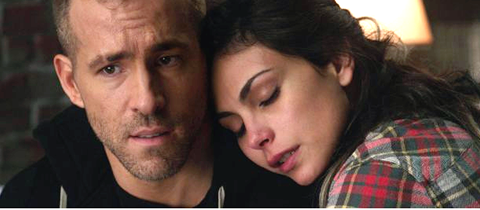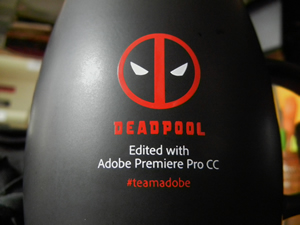Deadpool is not your father’s superhero movie, or, because of its R-rating, your kid’s either. Director Tim Miller was true to the comic book character, who has been rude-man-out in the Marvel Universe for 25 years. Miller was obviously going for shock and edginess and he succeeded.
 But one thing not obvious is how this tale was put together. Traditionally, major movies have been assembled on big, dedicated editing hardware and software costing as much as a Prius. Although Deadpool couldn’t have been put together on your father’s PC, it probably could on your kid’s.
But one thing not obvious is how this tale was put together. Traditionally, major movies have been assembled on big, dedicated editing hardware and software costing as much as a Prius. Although Deadpool couldn’t have been put together on your father’s PC, it probably could on your kid’s.
Adobe tools are bringing the power of Hollywood filmmaking to your home office.
After a screening of the film at Fox Studios Zanuck Theatre, on February 13, members of the Deadpool editorial and post-production team discussed how Deadpool was created in Adobe Premiere Pro. The panel was moderated by Adobe Senior Solutions Consultant Michael Kanfer, and included Post Supervisor Joan Bierman, First Assistant Editor Matt Carson, and Premiere Pro Editorial and Workflow Consultant Vashi Nedomansky.
The Film
Given what I had heard, I was totally prepared to dislike Deadpool. However, I found it entertaining from, literally, the beginning of the opening titles till the teaser at the end of the closing credits. And, it had Morena Baccarin (Firefly, Gotham) in it.
Deadpool is one of those rare films which violates so many rules of filmmaking and storytelling, it shouldn’t work, but it does. Also, it totally earns its “R” rating and no one under 17 should see this whether accompanied by a parent or guardian or not.
The Editing
Michael Kanfer kicked off the discussion by pointing out that Deadpool was not the first major film edited with Adobe software. Last year’s hit Gone Girl, directed by David Fincher, was done in Premiere Pro as was the recently released Hail, Caesar! by the Coen brothers. The difference was that Deadpool was not a product of the experimental indie-film world, but was a studio production with 1200 special effects.
Bierman, as Post Supervisor, was responsible for coordinating what happens to the film from when the video files leave the set until the finished product reaches the theaters. “It was a big challenge,” she said. “We knew the director wanted to ‘bring on the show’. So, the question for us was how to make this all work. We hired the best people we could then brought in your secret weapon, Vashi.”
Bierman was referring to Adobe Workflow Consultant Vashi Nedomansky.
Nedomansky recalled, “Joan brought me in to meet with Tim and Julian.” Julian Clark (Chappie, Elysium) was the editor. “I had worked on four features before, so I spoke their language.”
Kanfer asked, “You set up just five editing bays, right?”

Nedomansky explained, “But there was more to it than that. I spent a lot of time training people and understanding how they worked. Everyone has their own shortcuts and things they like to do with the keyboard. I set all that up. After that I was able to show them things you can do in Adobe that they didn’t know were there.”
Kanfer asked, “As the dailies started coming in, how did it go?”
Nedomansky said, “By the first afternoon Julian was cutting stuff. I didn’t know that was going to happen. I got a great response from him, and that rippled through the team.”
Troubles and Successes
The editing process was not without some problems, but these were mostly hardware related. The editing was done on Mac towers using D7 cards.
First Assistant Editor Matt Carson recalled, “We burned about 10 of those cards up.” The panelists laughed about the fact that besides the Mac’s internal fans, they had to put house fans on top of the machines to keep them cool.
According to Kanfer, Apple has acknowledged that this was a problem caused by their hardware.
Carson was proud of how fast they got the process working.
“We got 180 terabytes of SSD (solid-state-drive) storage,” he said. “This allowed us to keep up with Tim and Julian. By the end, we were able to get Adobe files open and ready to edit in two minutes.”
Innovations
Another thing that helped with Deadpool, according to Nedomansky, were the suggestions and changes asked for by David Fincher and his team last year during the editing of Gone Girl.

“They came from a Final Cut 7 background,” he said, “and now those things have been incorporated into Premiere Pro. The same process happened with Deadpool, but from editors with an AVID Media Composer background. These improvements should go into Premiere Pro next.”
One of the innovations developed during Gone Girl which has been particularly helpful to the Deadpool team, according to Kanfer, was the Adobe shared cache. “This allows the changes made on one workstation,” he said, “to be immediately seen on another.”
The old way to do this was to save, render, and import the files. What might have taken half-an-hour for complex effects could now be accomplished in seconds.
Did It All Work?
During a reception for press and filmmakers, sponsored by Adobe, before the screening, I spoke with an editing instructor from the UCLA Film School. I asked what he would be watching for in the film to see if Adobe could really cut it. None of the possible visual flaws he said might exist showed up.
Towards the end of the panel discussion, Kanfer asked Bierman if she considered the effort a success.
Bierman said, “The software gave us so much latitude that we were able to make fixes and add things closer to the locking of the release copy than on any other film I’ve worked on.”
She concluded, “We were all happy, and I think Fox will be happy on Monday morning, and that means some of us will be able to keep our jobs.”
Based on my reaction to the film, and the preliminary box office reports from Friday night, I think their jobs are pretty secure.




